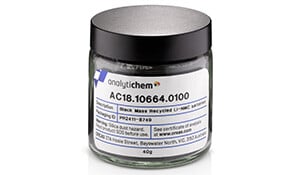Exciting News! Introducing the SNRG Block™ System by AnalytiChem Sample preparation is one of the...
New Product Alert: Proquinazid Acid Solution
We are excited to announce the addition of proquinazid metabolite IN-MU210 to the Analytichem fungicide portfolio!
Proquinazid: Benefits and Challenges
Powdery mildew is a fungal disease that affects many crops and can reduce their quality and yield. The fungicide Proquinazid has shown excellent performance against powdery mildew. It has a novel mode of action and residual activity and can be applied at low rates with low known environmental impact.
Once applied, proquinazid undergoes metabolic processes in plants and animals, resulting in the formation of different compounds, including Proquinazid Metabolite IN-MU210. Understanding the formation and properties of this metabolite is essential for assessing the overall behaviour and fate of proquinazid in the environment. As with many pesticides, research into the safety and effectiveness of proquinazid-based fungicides is ongoing.
The monitoring of proquinazid and its metabolite residues in food and environmental samples is essential to ensure food safety and environmental protection. The maximum residue levels (MRLs) for proquinazid and its metabolites are set by different authorities depending on the country and the crop. For instance, in the European Union, the MRLs for proquinazid in cereals vary from 0.02 to 0.1 mg/kg, while in grapes they are 0.5 mg/kg. The MRLs for proquinazid in animal products are 0.01 mg/kg for meat (except poultry liver) and 0.005 mg/kg for milk.
The marker residue for ruminant matrices (e.g., meat and milk) is proquinazid metabolite IN-MU210. Alternatively, the residue definition for enforcement in animal matrices is the ‘sum of proquinazid and metabolite IN-MU210, expressed as proquinazid’. This implies that the concentrations of both analytes are measured and summed to determine compliance with the legal limit.
Conclusion
Proquinazid, a quinazolinone fungicide, exerts a strong inhibitory effect on powdery mildew fungi by disrupting spore germination and appressorium formation. Its remarkable efficacy, residual activity, and low environmental impact make it a valuable tool for disease management. However, it's important to remember that proquinazid can undergo metabolic processes, leading to the formation of Proquinazid Metabolite IN-MU210. Accurate analytical methods are required to detect and quantify this metabolite. Reliable Proquinazid Metabolite IN-MU210 reference standards can be used to support research and development efforts related to proquinazid and its metabolites as well as for routine monitoring to ensure compliance with defined MRLs.
Contact us to learn more about our newest addition, Proquinazid Acid Solution (p/n MET-14080A1-1ML).
Request a quote now!
References:
- Review of the existing maximum residue levels for proquinazid according to Article 12 of Regulation (EC) No 396/2005 (wiley.com)
- Proquinazid (Ref: DPX KQ926) (herts.ac.uk)
- APVMA releases five minor-use permits - Grain Central
- Talendo Fungicide | Corteva Agriscience
- https://www.agropages.com/AgroData/Detail-1157.htm
- Ready Access to Proquinazid Haptens via Cross-Coupling Chemistry for Antibody Generation and Immunoassay Development - PubMed (nih.gov)

.png?width=50&name=MicrosoftTeams-image%20(1).png)





